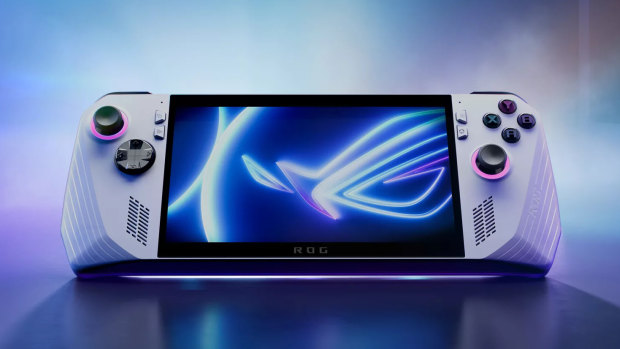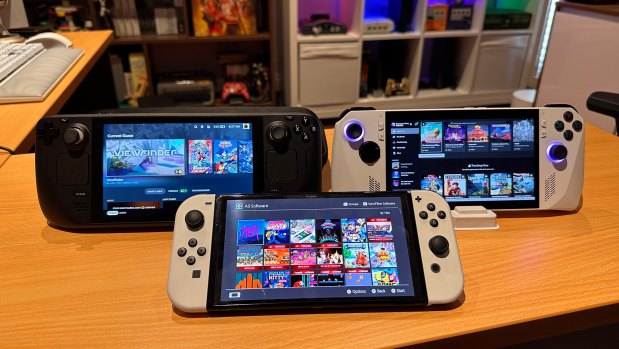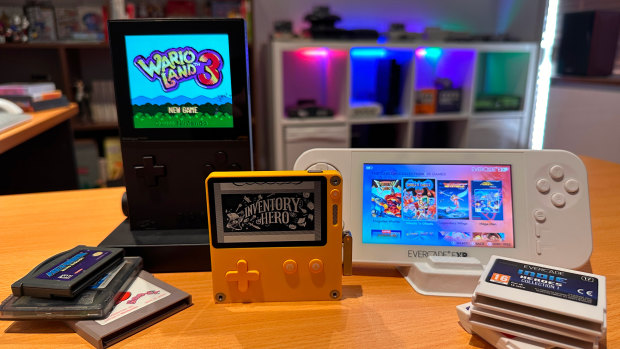By Tim Biggs
Throughout the 2010s, it was commonly thought that the smartphone would kill the market for handheld gaming consoles. Yet while mobile gaming has flourished into a multibillion-dollar industry, it hasn’t harmed dedicated portables at all. In fact, it seems to have helped them.
As mobile gaming has accelerated the number of people regularly playing games, sales of home consoles and gaming PCs have skyrocketed, and gaming handhelds have returned to relevance in a big way. Technological advancements, driven in large part by the smartphone industry, have created powerful components that can operate in small, battery-efficient devices. And the rising interest in retro and indie gaming has fostered communities that allow niche-interest handhelds to be economically viable, alongside more mainstream devices such as ASUS’ ROG Ally portable gaming PC, which just arrived in Australia last month.

The ASUS ROG Ally is the latest dedicated hand-held gaming device, able to play just about any game that works on Windows.
Players, as well as console makers, have realised that smartphones and dedicated consoles are good at different things, even if there’s a significant crossover in functionality. Smartphones will always be generalised devices for example, while dedicated game machines can have unique inputs and a variety of games made specifically for them. There’s also something to be said for keeping your leisure devices separate from your productivity machines.
The handheld renaissance arguably began with the Nintendo Switch in 2017. The Japanese gaming giant had maintained separate home consoles and handheld systems ever since the Super Nintendo and Game Boy more than 30 years ago. But with development costs rising, and the threat of mobile gaming eating into the business, spreading efforts across a number of devices made less sense. Its competitor and compatriot Sony abandoned its portable consoles entirely, but Nintendo merged its development staff into a single team and devised a console that could do both; play games on the go, or plug into a TV.
The time was right technologically speaking, as Nvidia’s line of Tegra chips — originally made for phones and tablets — could power portable games for hours as well as create Full HD graphics on the big screen. And the Switch seemed to hit at the right time for players, too. It’s become practically the only mainstream games system in Japan, and worldwide has been more successful than any of Nintendo’s home consoles. With the standard $470 Switch, the $330 portable-only Switch Lite and the $540 OLED model combined, it has sold more than 125 million units.

Valve’s Steam Deck (left) lets you take games from its online store with you, while the Nintendo Switch (front) is by far the most popular currently-sold video games machine.Credit: Tim Biggs
While Nintendo was releasing the Switch, a portable machine was also being developed at Valve, the US company behind ubiquitous PC gaming storefront Steam. The Steam Deck is essentially a powerful Linux laptop with game controls built in, but its strength is how it essentially consolises the complicated and potentially overwhelming PC gaming landscape. Valve constantly enhances its Proton software, which lets games designed for Windows run smoothly on Linux, and assesses every one of the thousands of games on the Steam store to gives each one of four compatibility ratings, so you know a game will work before you buy it.
It also has a range of inputs, including touchpads and a gyroscope — paired with a clever system that lets you copy controller settings from other players around the world — which makes PC games from high-end releases like Elden Ring to indies like Dave the Diver very accessible. Battery life can be a bother, coming in as low as 90 minutes in some cases. But there is a wealth of options to let you trade performance for more juice. Valve does not yet officially sell the Steam Deck in Australia. In the US, it starts at $US400 ($590).
Australians aren’t completely left out though, as ASUS’ aforementioned ROG Ally is an impressive alternative that gives a window into where portable games may be headed, even if it comes with a few caveats. With extreme processing power, customisable lighting and an incredible screen that can handle Full HD and high refresh rates, it’s like a desktop PC gaming system squished into a handheld. As with the Steam Deck, a key selling point here is that you have access to decades of PC games plus brand new releases. And as Sony and Microsoft move away from a console focus to a services focus you increasingly get Xbox and PlayStation games on PC as well, like Halo and God of War.
The main difference between the Deck and the Ally (aside from price; the Ally is $1300) is that the latter runs Windows, which greatly expands your options in terms of where you can get games. The downside is that Windows really isn’t designed for devices like this, and ASUS’ software isn’t up to the challenge of streamlining it, so it’s overall a glitchier and more fiddly experience. Battery life is also worse than Steam Deck for the same games, but again you can limit power to help remedy this. There’s a long way to go before you could easily recommend this device to someone who isn’t familiar with PC gaming or the inner working of Windows, but the appeal of PC games on the go is undeniable.
Over the past two years, the market for more niche, nerdy and more straightforward handheld devices has also flourished.
The Playdate is a very cheerful little machine for fans of quirky games made by individuals or small teams. Created by US software company Panic (publisher of Aussie hit Untitled Goose Game), it has a reflective monochrome screen and an idiosyncratic little crank you can use for some games, in addition to the traditional controls. Is it pretentious? Yeah, a little. But it also leverages modern connectivity to deliver new and unique game ideas in a way no other company has tried. When you buy a Playdate (around $300) you also get 24 really good games, which arrive over Wi-Fi two at a time, once per week, for three months of surprises. When you’re done, there’s a tightly curated store, or you can buy direct from creators and send the games to your device over the web.

The Analogue Pocket (left) works with retro cartridges, the yellow Playdate is a platform for quirky indies, and the Evercade EXP has a library of arcade and old-school games on new cartridges.Credit: Tim Biggs
The Analogue Pocket is targeted towards retro collectors, and it looks and feels like the ultimate Game Boy. The Pocket uses special chips called FPGAs to emulate older consoles at a hardware level, which the US-based Analogue has done to great effect previously with its Super Nintendo and Sega Mega Drive clones. In this case it has a cartridge slot into which you can plug any Game Boy game (original, Color or Advance), and it plays wonderfully on a beautiful screen that’s such a high resolution it can even emulate the LCD subpixel patterns of the old displays, so games look exactly as intended but cleaner and brighter. Plus a second FPGA lets developers publish cores for other systems from home consoles to arcades. In theory this would let you copy your whole retro gaming collection to digital files and play them on the go with a single device, though it’s important to note that would be illegal in Australia. The pocket is around $330, plus (exorbitant) shipping.
And finally the Evercade EXP is for the retro gaming fan who prefers old games on brand new cartridges; kind of like if you wanted to collect albums on vinyl, but went for the modern repros rather than the ancient originals. Blaze — the company behind Evercade — partners with publishers and rights holders to release cartridges that generally contain between four and 10 games, and come with their own shelf-ready cases and physical manuals that are as much miniature retrospective articles as they are instruction booklets. It’s a great little device for playing arcade, console and home computer games on the go (you can even rotate it to play vertical shooters in the proper orientation), and a few cartridges feature brand new retro-style releases from modern indies. The $250 EXP comes with one cartridge — six games from Irem including R-Type — as well as 18 built-in games from Capcom, including Street Fighter II’: Hyper Fighting and Mega Man 2.
Get news and reviews on technology, gadgets and gaming in our Technology newsletter every Friday. Sign up here.